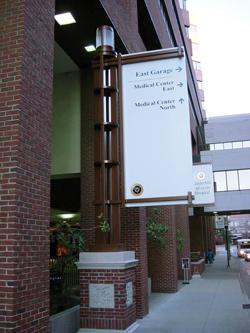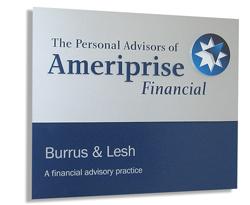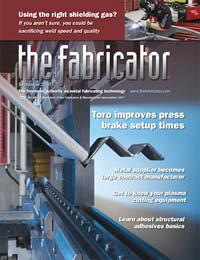- FMA
- The Fabricator
- FABTECH
- Canadian Metalworking
Categories
- Additive Manufacturing
- Aluminum Welding
- Arc Welding
- Assembly and Joining
- Automation and Robotics
- Bending and Forming
- Consumables
- Cutting and Weld Prep
- Electric Vehicles
- En Español
- Finishing
- Hydroforming
- Laser Cutting
- Laser Welding
- Machining
- Manufacturing Software
- Materials Handling
- Metals/Materials
- Oxyfuel Cutting
- Plasma Cutting
- Power Tools
- Punching and Other Holemaking
- Roll Forming
- Safety
- Sawing
- Shearing
- Shop Management
- Testing and Measuring
- Tube and Pipe Fabrication
- Tube and Pipe Production
- Waterjet Cutting
Industry Directory
Webcasts
Podcasts
FAB 40
Advertise
Subscribe
Account Login
Search
Structural adhesives form strong bond with signage
10 questions about joining metal to metal, metal to plastics
- By Scott Miller
- September 11, 2007
- Article
- Assembly and Joining
Sign-makers have long sought a way to improve durability and aesthetics and reduce the labor-intensive steps associated with welding, taping, and fastening. Today's adhesives can structurally bond metals to plastics with unique design, production, and cost benefits.
Structural adhesives are an alternative to welding and mechanical fasteners for sign industry fabrication.
1. How Strong Are Structural Adhesives?
The shear strengths of today's structural adhesives are from 1,000 to 4,000 pounds per square inch (psi)—resulting in joint strengths comparable to most welding and conventional fastening methods when those joints are properly designed. Also, adhesives maintain their strength over a wide temperature range (–40 to 170 degrees C). Additionally, unlike screws, bolts, or rivets that concentrate the stress at the point of attachment, adhesives spread the stress over the entire bond area.
2. Which Materials Can Adhesives Join?
Many fabricators have concerns or are unaware about which materials can be bonded using adhesives. Using today's techniques and products, fabricators can use adhesives to join aluminum, stainless steel, cold-rolled steel, brass, copper, and most other metals. Further, adhesives can bond ABS, acrylic, polycarbonate, foam, trim caps, wood, and fiberglass, and they can be used with most factory-painted metals.
3. What Do I Need to Know About Cross-bonding?
When you are cross-bonding, such as joining metal to plastic, it is important to consult an adhesive supplier to ensure that you use the correct application.
Because extreme differences may exist in the expansion coefficients of metal and plastic, substrates may expand and contract at different rates with temperature changes. It is important to keep two factors in mind: First, the design must be flexible enough to accommodate the expansion. Trying to completely restrain a structure from expanding can create enormous stresses that no fastening method can tolerate. If space is permitted for parts to bow and flex, then the thermal expansion is accommodated, to some extent.
The second factor is that the adhesive and substrates must be strong enough to tolerate the stresses that the thermal expansion produces. Stresses of several thousand psi are not uncommon, even in a well-designed structure, so the adhesive chosen must be able to withstand stresses of these levels.
4. When Are Adhesives Not Suitable?
Sometimes an adhesive is not appropriate. The rule of thumb is to use adhesives only where the joint design is loaded in shear or compression, not peel or tension. Areas like butt joints or T joints do not always allow a sufficient overlap for the adhesive to bond properly. Sometimes it is faster and simpler to assemble these designs by welding or fastening.
5. Which Adhesive Works Best on Which Surface?
An adhesive's chemistry is a key indicator in determining which substrates it can bond. It is important to understand the adhesive's correct work time, fixture time, and handling strength. Adhesives are based on polymers made from acrylics, urethanes, or epoxies, and each has unique properties:
- Acrylic-based adhesives are particularly effective in bonding metals. They are very aggressive and require minimal surface preparation. Acrylic adhesives work well on plastics, but because they are so aggressive, they may craze or stress-crack some plastics.
- Epoxies can be used on metal, plastic, concrete, wood, and foam. Because epoxy-based adhesives tend to have a slow cure rate and become brittle at low temperatures, acrylics and urethanes are sometimes better choices when production process timing is critical or when parts will be used in very low temperatures.
- Urethanes are a good choice for bonding plastics, wood, and foam. Urethanes do not adhere well to metal without a primer, however, so they are not used as often for metal bonding.
6. How Are They Applied?
Structural adhesives now are available in cartridges with an applicator that permits instant application without measuring and hand-mixing. Minimal surface preparation is required.

CAGI used structural adhesives to construct metal frames and to attach materials to those frames for signage at Vanderbilt University, Nashville.
Most structural adhesives are cured by combining two chemical components. When dispensed from cartridges, the two components go through a mixing tube and are then applied directly to the surfaces to be joined.
7. How Long Does the Process Take?
The time between leaving the mixing tube and when the joint must be held stationary to allow the adhesive to cure is work time. Work time, also referred to as pot life or assembly time, is the time available to use an adhesive after it is mixed.
Fixture time, or handling time, is the time required to hold the parts stationary before they can be handled. This is the time required for the adhesive to build up sufficient strength to allow removal of fixturing devices and permit careful handling of the parts. Typically, when an adhesive has acquired a shear strength of 50 to 100 psi, the part can be handled.
Because manufacturing processes vary widely, the handling time for parts also can vary and usually must be determined individually. Full cure time is the amount of time needed for the adhesive to be almost at its ultimate strength. The adhesive usually is considered to be fully cured when it has reached at least 90 percent of its ultimate strength.
Adhesive manufacturers base these strength values on a specific temperature, such as 25 degrees C. As the temperature increases, the chemical reaction time decreases, often significantly. For example, in the summer when temperatures reach 40 degrees C, work time may be 50 percent less than work time during the winter. The substrate's temperature also can influence cure properties; as it increases, the adhesive cures faster.
8. How Do I Prepare the Surface for Application?
Surface preparation is important in any bonding application. Dust, dirt, grease, oil, adhesive residue, and anything that can get between the adhesive and the substrate can be a possible source of failure. The surface preparation can be as simple as wiping with a clean rag. Isopropyl alcohol can dissolve contaminants, although scuffing or grinding may be required in some cases. The best source for information about proper surface preparation is the adhesive supplier.
9. What Safety Precautions Must I Take?
Because adhesives contain chemicals, you need to wear protective equipment and clothing. Safety glasses or goggles and gloves should be worn when applying adhesives. The area should be sufficiently ventilated to protect you from fumes and vapors.
10. What Else Do I Need to Know?
Adhesives can compensate for dimensional irregularities by filling in small gaps on poor-fitting parts. They also can act as a sealant, keeping out moisture that causes hazards and maintenance issues with the electrical components in the sign.
Cost is key to success to any fabrication process change. Overall, adhesives can reduce the cost to manufacture a sign, as well as improve the aesthetics and the durability (see sidebar).
Architectural Sign-Maker—
Case Example
Although the initial cost of adhesives may be more than a rivet or a screw, adhesives can save labor and application time and eliminate other material costs. Such was the case for Architectural Graphics Inc. (AGI), Virginia Beach, Va., a manufacturer of custom interior and exterior architectural signs and multifacility sign projects for high-profile companies like Chase, Cisco, and Ameriprise.

When considering the use of an adhesive for a metal sign, a fabricator should consult the adhesive supplier.
According to Richard Sorensen, AGI plant manager, customers demand that their sign products have a very clean, finished appearance. "We simply cannot achieve the high-end, finished look our customers desire with conventional welding or mechanical fastening methods because of the effects of combining dissimilar materials or distortion transfer through the surface material," said Sorensen.
AGI conducts several strength tests to ensure the correct method of adhesion and aesthetics are engineered into the product. After running the structural calculations, they make a small test part or a scale prototype. Then the sign-maker runs the test part through physical tests, including load testing, temperature expansion and contraction, paint adherence, and cosmetics.
As a result, the adhesives improve the signs' appearance and reduce postfabrication processing time, Sorensen said.
"Our main cost reduction is in the labor in the paint and finishing segment of our business," said Sorensen. "Also, the adhesives do not telegraph as much to the primary surfaces of our products, improving the aesthetics and durability."
About the Author
Scott Miller
111 Lord Drive
Cary, NC 27511
subscribe now

The Fabricator is North America's leading magazine for the metal forming and fabricating industry. The magazine delivers the news, technical articles, and case histories that enable fabricators to do their jobs more efficiently. The Fabricator has served the industry since 1970.
start your free subscription- Stay connected from anywhere

Easily access valuable industry resources now with full access to the digital edition of The Fabricator.

Easily access valuable industry resources now with full access to the digital edition of The Welder.

Easily access valuable industry resources now with full access to the digital edition of The Tube and Pipe Journal.
- Podcasting
- Podcast:
- The Fabricator Podcast
- Published:
- 04/16/2024
- Running Time:
- 63:29
In this episode of The Fabricator Podcast, Caleb Chamberlain, co-founder and CEO of OSH Cut, discusses his company’s...
- Industry Events
16th Annual Safety Conference
- April 30 - May 1, 2024
- Elgin,
Pipe and Tube Conference
- May 21 - 22, 2024
- Omaha, NE
World-Class Roll Forming Workshop
- June 5 - 6, 2024
- Louisville, KY
Advanced Laser Application Workshop
- June 25 - 27, 2024
- Novi, MI
































